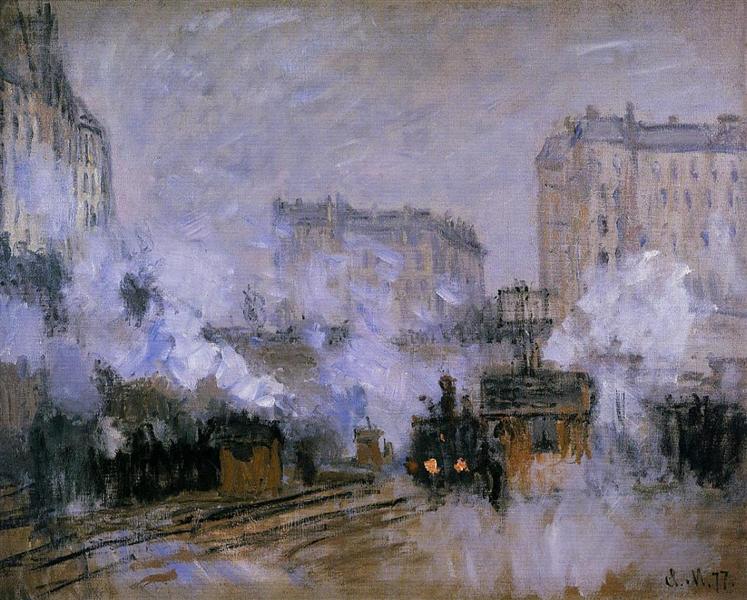Beschrijving
Claude Monet's painting "St. Lazare Station - Arrival of a Train", created in 1877, stands as a fundamental milestone in the development of Impressionism and, at the same time, as a testament to the modern spirit of the 19th century. Monet, one of the main exponents of this movement, captures in this work an ephemeral and dynamic moment, characteristic of the changing society of his time. The scene depicted, which takes place in the emblematic Saint-Lazare railway station in Paris, encapsulates the fusion between industrial architecture and human movement, allowing the viewer to witness a new era marked by progress and modernization.
Visually, the composition of this painting is rich in detail and complexity. Monet employs a subtle, vaporous color palette, with grays and blues predominating, along with touches of white and ochre that allude to the fog and smoke emanating from the locomotive. This color choice not only evokes the atmosphere of the place, but also reflects the way light interacts with different surfaces, a recurring theme in Monet's work. The use of loose, rapid brushstrokes is characteristic of Impressionism, inscribing on the canvas the immediacy of the visual experience and a sense of movement, both in the rising steam and in the train itself, which figuratively seems to break into the scene.
As the viewer looks at the painting, it is easy to notice that the characters, although present, are not the main focus of the work. The human figures, which are outlined at various points in the station, seem almost blurred by the steam and light, suggesting a moving crowd. This approach reinforces the vision of contemporary man as part of a larger system, a reflection of modern life in which technological progress not only transforms the urban landscape, but also everyday existence. The few discernible figures are characters in a constantly changing world; their expression and gestures are subordinated to the spectacle of the train and the station itself, which act as protagonists in this visual narrative.
Furthermore, this painting is part of a series that Monet made about the Saint-Lazare station. These works are often considered to mark an evolution in his style, in which a greater focus on light and movement can be seen. Monet experimented in this series with different effects of light and shadow, which allowed him to explore the atmosphere of the railway as a symbol of modernity. The train station here functions as a microcosm in which contemporary urban experience and human interaction with technical innovation are condensed.
The historical context is also relevant in the appreciation of Arrival of a Train, as trains and railroads symbolized progress and the rapid industrialization of Europe. Monet, aware of this social and cultural transformation, not only captures a moment in time, but also documents an era of change that deeply impacted everyday life. This escape from the traditional to the modern is reflected in the very structure of the painting, where realistic representation is amalgamated with a completely new approach to light and color, full of ambiguity and vibrancy.
In short, “St. Lazare Station - Arrival of a Train” is more than just a depiction of a train station; it is an exploration of movement, modernity, and the transformation of society. Monet, with his evocative use of color and light, makes the viewer not only observe but also feel the pulse of life in an industrial age, striking a balance between the tangible and the ethereal. This work is not only a testament to his technical mastery, but is also a profound reflection on a crucial moment in history, where art and life are inextricably intertwined.
KUADROS ©, a famous painting on your wall.
Hand-made oil painting reproductions, with the quality of professional artists and the distinctive seal of KUADROS ©.
Painting reproduction service with satisfaction guarantee. If you are not completely satisfied with the replica of your painting, we will refund 100% of your money.

